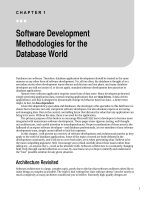Interacting with the Outside World Using Simple IO Devices
Bạn đang xem bản rút gọn của tài liệu. Xem và tải ngay bản đầy đủ của tài liệu tại đây (310.32 KB, 24 trang )
Chapter 2
Interacting with the Outside World Using
Simple I/O Devices
The microcontroller interacts with the outside world by means of devices such as
LEDs, relays, LCDs extra. This chapter covers all the interfacing aspects of PIC to
the outside world. The interfacing aspects in general comprises of solving the
current/voltage in compatibility issues, introducing drivers, current protection
resistors, port saving measures and satisfying the timing requirements. A good
reference to solve these incompatibility issues may be seen in the online URL given
at reference [53]. The code developed in this chapter is quite useful and may be
treated as a software library in any project design.
Following case studies are developed:
2.1
LED Interfacing
2.2
Switch (DIP) Interfacing
2.3
Interfacing Buzzer
2.4
Keypad Interfacing
2.5
Thumbwheel Switch Interfacing
2.6
Seven Segment Display Interfacing
2.7
LCD Interface to the PIC
2.8
Relay Interface to the PIC
2.1 LED Interfacing
LEDs the tiny semiconductor devices, passes an electric current to in only one
direction and produce light as a byproduct of current flow. These days they have
challenged the mere existence of the fluorescent lights, as they run cooler and last
longer. The lighting industry is being dominated by LEDs and they are now domi-
nating the commercial world, with their optimum energy use and lesser mainte-
nance costs. Recently even the video screens, animated signs, traffic lights and
home lights are some of the domains being ruled by the arrays of tiny LEDs.
The role of LED’s as a binary indicator for indication and diagnostics is undis-
putable. Although it is one of the most simplest interfacing, it presents a range of
opportunities when used for applications such as advertisement displays, home
J.S. Parab, et al., Practical Aspects of Embedded System Design using Microcontrollers, 19
© Springer Science + Business Media B.V. 2008
20 2 Interacting with the Outside World Using Simple I/O Devices
show pieces, etc. Many of the embedded system products makes use of the SMD
LED’s (owing to manufacturing ease) although they are less brighter than their
through hole counterparts.
The LEDs can be interfaced to the microcontroller in either in ‘active high’ or
‘active low’ mode. However the ‘active low’ mode gives certain advantages as ground-
ing the cathode is much easier and reliable than outputting logic 1 from the port pin.
With the active low mode the sinking capacity of the microcontroller is more important
than the sourcing. In this module three case studies pertaining to the LED interfacing
have been developed useful for different applications in Embedded Systems.
Program 2.1
Blinking of the LED
This application is analogous to the “Hello World” program for the software engineer
in making. This simplest LED interfacing (Fig. 2.1) exercise helps to kick start the
programming and enhances the confidence level. It also clarifies the basic infinite
loop theory of the embedded systems by using while{1} construct. The concept of
passing the delay values to the built in delay routine in the PIC C is demonstrated.
Program Source Code
******************************************************************************
// Program to illustrate the blinking LEDs connected to the Port B of PIC16F877.
——————————————————————————————————————-
#include<16f877.h>// Include the header file of the PIC16F877 device.
#use delay(clock=20000000)// Use the clock of 20 MHz for the delay
void main()// Start of the main program.
{
while(1) // loop for the LED ON-Off.
Fig. 2.1 LED interface to PIC16F877
2.1 LED Interfacing 21
{
output_b(0×ff); // Out 0XFF to the Port B.
delay_ms(500); // Delay of 500 ms.
output_b(0×0); // Out 0X 00 to the port B.
delay_ms(500);
}// end of for loop.
}
******************************************************************************
Blinking frequency variation can be verified by changing the delay count.
Program 2.2
Blink and send the data pattern stored in array
The application is all about making a configurable LED arrays by sending the display
data pattern through an array. A slight extension of this application with more LEDs
connected to the other ports (which will form the LED matrix) is quite useful for display-
ing the moving images with limited animation. In the present application, patterns to be
displayed are stored in an array and sent to the LEDs interleaving a short blinking.
Program Source Code
************************************************************************************
/* Program for the LED interfacing to the PIC16F877. LEDs are connected to the
port B. The LEDs are ON-Off with the predefined software delay. And after ON-
Off 10 times send the data stored in Array.
Program to illustrate the blinking and sending the data pattern stored in array to the
LEDs connected to the PIC16F877.*/
——————————————————————————————————————————–
#include<16f877.h> // Include the header file of the PIC16F877 device.
#use delay(clock=20000000) // Use the clock of 20 MHz for the delay
unsigned int led[]={0×FE,0×FD,0×FB,0×F7,0×EF,0×Df,0×Bf,0×7f};
unsigned int i; // define the integer.
void main() // Start of the main program.
{
while(1) // loop for the LED ON-Off.
{
for(i=0;i<10;i++) // switch leds ON-OFF for 10 times
{
output_b(0×ff); // Out 0×FF to the Port B.
delay_ms(500); // Delay of 500 ms.
output_b(0×0); // Out 0× 00 to the port B.
delay_ms(500);
} // end of for loop.
for(i=0;i<8;i++) // send the sequence stored in arrray
{
output_d(led[i]); // Send the Data stored in the Array.
delay_ms(500); // Delay of 500 ms.
}
} // End of While loop
} // End of main.
******************************************************************************
22 2 Interacting with the Outside World Using Simple I/O Devices
Program 2.3
LED ON-OFF by using shift operators
This application is one step towards “scrolling marquee LED signs”. Such applica-
tions make use of the IC shift registers for the purpose of scrolling. However, the
same is achieved by using the ‘shift’ operator that scrolls the data pattern stored in
an array in a sequential fashion.
Program Source Code
******************************************************************************
//This Program for LED interface
//Data Lines – PORT B
—————————————————————————————————————-
#include<16f877.h>
#use delay(clock=20000000)
unsigned int i;
char a;
void main()
{
a=0×01;
while(1)
{
for(i=0;i<10;i++){ // switch leds on OFF for 10 times
output_b(0×ff);
delay_ms(500);
output_b(0×0);
delay_ms(500);
}
for(i=0;i<8;i++)
{
output_b(a);
delay_ms(500);
a=a<<1; // send the sequence stored in array
if (a==0×0)
a = 0×01;
}} }
******************************************************************************
2.2 Switch (DIP) Interfacing
Program 2.4
DIP switch interfacing
A Dual In Line Package (DIP) switch is an electric switch that is packaged in a group in
a standard dual in-line package (DIP). DIP switches are primarily used for setting up vari-
ous configuration options. Some of the applications of the DIP switches are as follows:
●
Configuring of defaults on computer boards
●
Changing the baud rate on modems
●
Setting default options for video cards
●
Configuration of pin-outs on cables
●
Assigning address on the PC’s system bus to an peripheral or I/O bus
●
Selecting IRQs in PCs
The DIP switches can be interfaced to the microcontroller either by using a pull-up
resistor (i.e. by connecting the switches to Vcc through a current limiting resistor) or
in a pull-down mode with a small value resistor between the microcontroller pin and
ground. The former method ensures the sinking current limitations of the microcon-
troller pin although it gives logic 0 for switch closure. The latter method as shown in
Fig. 2.2 gives logic 1 for the switch closure, however results in a larger current dissi-
pation during the switch closure. In this application status of the DIP switches is read
through port B and the same is sent to the LEDs interfaced to port D.
Program Source Code
*****************************************************************************
/* This program will read the DIP switched connected to port B and outputs the
same on LEDS, which are connected to port D */
2.2 Switch (DIP) Interfacing 23
Fig. 2.2
DIP switch interface to PIC16F877
24 2 Interacting with the Outside World Using Simple I/O Devices
// Data Lines (DIP switched is connected to PORT B
// LEDs are connected to PORT D
————————————————————————————————————
#include<16F877.h>
#use delay(clock=20000000)
unsigned char read; // Define the Character Read
void main() // Start of the main function.
{
output_d(0×ff); // Out the 0X FF to the Port D connected to LEDs
while(1)
{
read=input_b(); // Read the data from the DIP switch connected to the
Port B.
delay_ms(500); // Delay of 500 ms
output_d(read); // Out the Read data to port D.
}
}
******************************************************************************
2.3 Interfacing Buzzer
Piezoelectric sound components are known for their penetrating tones that are free
of harmonics. These devices works on the principle of activating the piezoelectric
diaphragm that consists of a piezoelectric ceramic plate with electrodes on both
sides and a metal plate either of brass or stainless steel. With their low power
requirement, these devices can be driven by the microcontroller port to produce
high acoustic output. With the Application of the DC voltage through the port line
causes these devices to produce mechanical distortion to the diaphragm. Even by
applying an AC voltage/variable pulses using the timer counter of the microcontrol-
ler will move the diaphragm in a repeated bending motion, creating different sound
effects. The devices such as Murata’s PKB24SPC-3601-B0 piezoelectric buzzers
[51] are useful for microcontroller interfacing.
Program 2.5
Buzzer interfacing
This application demonstrates a buzzer interfacing to the PIC microcontroller (refer
Fig. 2.3).
Program Source Code
******************************************************************************
/* Program illustrates the interfacing of the Buzzer connected to the pin 0 of the
Port D. with the predefined software Delay. */
——————————————————————————————————————–
#include<16F877.h>
#use delay(clock=20000000)
void main()
{
while(1)
{
output_high(PIN_D0); // buzzer is connected to pin D0
delay_ms(300);
output_low(PIN_D0);
delay_ms(300);
}
}
******************************************************************************
Program 2.6
Activating buzzer with pin sense
This application is all about activating the buzzer upon pressing the push button
key. It can be modified for many possibilities such as ‘quiz buzzer’, ‘safety alarm’,
etc. Debouncing has to be done whenever the mechanical switches are involved.
This is accomplished by introducing a software delay in this application.
2.3 Interfacing Buzzer 25
Fig. 2.3
Buzzer interface to PIC16F877
26 2 Interacting with the Outside World Using Simple I/O Devices
Program Source Code
******************************************************************************
/* This program illustrate the Pin D1 is connected to push button which will act as
an input. The Status is indicated by the Buzzer activation connected to the port pin
D0. /*
————————————————————————————————————
#include<16F877.h>
#use delay(clock=20000000)
void main()
{
while(1)
{
if(input(PIN_D1)==0)
{
output_high(PIN_D0); // buzzer is connected to pin D0
delay_ms(50);
}
else
{
output_low(PIN_D0);
delay_ms(50);
}
}
}
******************************************************************************
2.4 Keypad Interfacing
Almost all the embedded instruments require a front panel keypad interface to
facilitate modifications of the instrument settings. The Series 96 is Grayhill’s most
economical 4 × 4 keypad family [1,2]. The contact system utilizes conductive rub-
ber to mate the appropriate PC board traces. These keypads are offered in matrix
circuitry, with shielded and backlit options. The specifications required for interfac-
ing (refer Fig. 2.4) are reproduced here. More details are available from the com-
pany website available at reference 1. The 10 K resistor works as a pull up resistor
for the active row input.
Specifications:
●
Rating Criteria
●
Rating at 12 Vdc: 5 mA for 0.5 s
●
Contact Bounce: <12 ms
●
Contact Resistance: <100Ω (at stated operating force)
●
Voltage Breakdown: 250 Vac between components
●
Mechanical Operation Life: 1,000,000 operations per key
Program 2.7
Hex keypad interfacing
The program works on the principle of scanning the rows and columns. The key
pressed is displayed on the PC through HyperTerminal.
Program Source Code
******************************************************************************
// Program for On-Board Key interface
————————————————————————————————————
#include<16F877.H>
#use delay(clock=20000000)
#use rs232(baud=19200,xmit=PIN_C6,rcv=PIN_C7)
unsigned char row1[4]={0×fe,0×fd,0×fb,0×f7},value;
unsigned char row,col,colread,a,b,c,i;
void display(int );
void main()
{
printf(“ n r Key Interface”);
while(1)
{
row=0×fe;
delay_ms(500);
for(i=0;i<4;i++)
{
output_d(row);
colread=input_d();
col=colread &0×f0;
2.4 Keypad Interfacing 27
Fig. 2.4 Hex keypad interfacing









